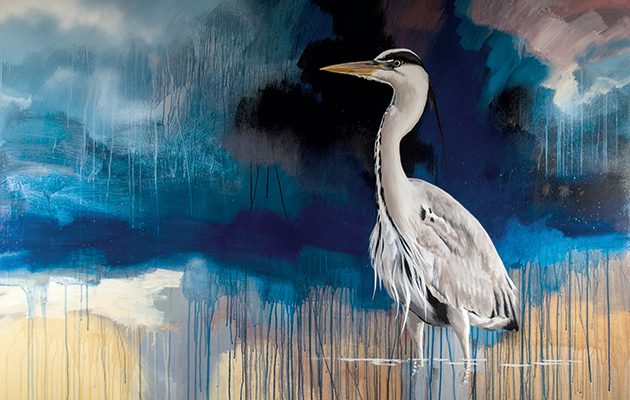This heron has become a metaphor for Jim Starr's professional journey, finds Janet Menzies, situated as it is in the margins like a punctuation mark between the urban and the wilderness
Jim Starr was inspired by his love of birds and influenced by the street art and graffiti of Bristol and London. At first too edgy for London galleries Starr could only show his art in clubs and bars until the artistic landscape began to change.
For more sporting artists, Clare Brownlow put unwanted pheasant tails to a good use and took unusual inspiration from a dripping pen. And Jolyon Madden‘s work is as attention grabbing as his front page splashes for The Sun.
JIM STARR
One of the great joys of interviewing artists is discovering their subject matter. Horses gallop through the conversation, shaking their manes; honey-heather grouse moors fly into focus. In the case of Jim Starr, it’s a little disconcerting to have a roughly life-size bateleur eagle glaring down at you from the canvas. A single speck of white on the eagle’s eye conveys exactly the contempt with which it views its prey, and you, and probably the world in general.
“Maybe it’s a self-portrait?” jokes Starr. Definitely not. If any of his works is a self-portrait then it has to be his heron, standing in the mud of the Thames near Hammersmith Bridge at low tide. “I got this amazing commission to do a series of massive landscapes of London and the Thames to be hung in the public areas of a new luxury apartment building on the river,” Jim Starr says, explaining how it came about. “It was quite a challenge – even just the scale of the paintings. I had to hire some space in the Bristol Old Vic theatre where they paint the scenery flats, because that was the only place big enough to put the canvases.
“I really had to rethink my way of working because my previous subject matter wasn’t appropriate – but it was a beneficial process. It was all a mile away from what I had done before but I had this train of thought about the margins of the Thames. Of course, the heron is a bird of the river margin.” And so a heron appeared, a pale punctuation mark on the mud grey of the riverside. The heron had disappeared by the final painting but it was too late, the course of Starr’s work had been changed. “I went back to Bristol and painted it all over again.
“That was when it clicked and I realised that this was where I wanted to go with my work. Brought up in the Westcountry, I’ve loved birds and wildlife ever since I was a child. I still have a little painting of a kingfisher I did when I was 12. I always wanted to be an artist, so I went to Chelsea College of Art.”
Surrounded by urban art and graffiti in Bristol (the home of Banksy) and London, Starr’s early work was heavily influenced by street art and American graphic art at a time when it was still considered pretty edgy by traditional London galleries. “You just couldn’t find a place to exhibit,” he remembers. “Damien Hirst and the Young British Artists had to organise their own shows. Street art and urban art wasn’t accepted by the mainstream galleries. It took Banksy really to blow the doors open and create channels for artists like me to exhibit. I would show my work in clubs, bars and restaurants.”
Starr’s urban-influenced collages and screen prints showed his passion for the wilderness and its birds. His series of screen prints of hummingbirds deliberately references Andy Warhol’s screen prints of Marilyn Monroe. His collages of African tribespeople feature the sacred ibis or a vulture haunting the backcloth. These come from his work as an expedition artist into wild places. “It’s an unusual role these days to be an expedition artist, when everything is usually just filmed. I work in the field with my sketchbook. You end up with less sleep than anyone else on the expedition but you have to cram it in. You want to be a team player and chip in with the cooking, etc, but you do have to do the creative work as well.
“Until the heron painting, I think that although my work was successful I was really all over the place with my influences and techniques,” Jim Starr confesses. “But now I have found my expression. I want to do all these huge bird portraits. I feel I have thousands of ideas – there are 10,700 species of bird, after all – and I want to bring my pop and urban art inspirations to depict the birds as really powerful images.”
So the heron painting mirrors Starr’s own journey as an artist. Where the Thames brings the wild into the heart of the city stands the heron, just like Starr’s work as an urban artist with the natural world as his subject.
The heron that started it all is at Rountree Tryon Galleries, 7 Bury Street, London SW1Y 6AL (www.rountreetryon.com). To see more of Jim Starr’s work visit: www.screenprintjim.com





